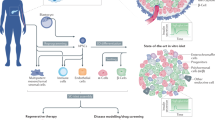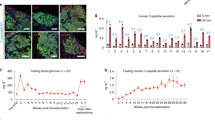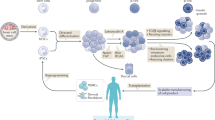Abstract
In this Perspectives article, we comment on the progress in experimental stem cell and gene therapies that might one day become a clinical reality for the treatment of patients with diabetes mellitus. Research on the ability of human embryonic stem cells to differentiate into islet cells has defined the developmental stages and transcription factors involved in this process. However, the clinical applications of human embryonic stem cells are limited by ethical concerns, as well as the potential for teratoma formation. As a consequence, alternative forms of stem cell therapies, such as induced pluripotent stem cells and bone marrow-derived mesenchymal stem cells, have become an area of intense study. Finally, gene therapy shows some promise for the generation of insulin-producing cells. Here, we discuss two of the most frequently used approaches: in vitro gene delivery into cells which are then transplanted into the recipient and direct delivery of genes in vivo.
This is a preview of subscription content, access via your institution
Access options
Subscribe to this journal
Receive 12 print issues and online access
$209.00 per year
only $17.42 per issue
Buy this article
- Purchase on Springer Link
- Instant access to full article PDF
Prices may be subject to local taxes which are calculated during checkout

Similar content being viewed by others
References
Shapiro, A. M. et al. Islet transplantation in seven patients with type 1 diabetes mellitus using a glucocorticoid-free immunosuppressive regimen. N. Engl. J. Med. 343, 230–238 (2000).
Ryan, E. A. et al. Five-year follow-up after clinical islet transplantation. Diabetes 54, 2060–2069 (2005).
Smith, R. N. et al. Pathology of an islet transplant 2 years after transplantation: evidence for a nonimmunological loss. Transplantation 86, 54–62 (2008).
Cardona, K. et al. Long-term survival of neonatal porcine islets in nonhuman primates by targeting costimulation pathways. Nat. Med. 12, 304–306 (2006).
Hering, B. J. et al. Prolonged diabetes reversal after intraportal xenotransplantation of wild-type porcine islets in immunosuppressed nonhuman primates. Nat. Med. 12, 301–303 (2006).
Valdés-González, R. A. et al. Xenotransplantation of porcine neonatal islets of Langerhans and Sertoli cells: a 4-year study. Eur. J. Endocrinol. 153, 419–427 (2005).
Kroon, E. et al. Pancreatic endoderm derived from human embryonic stem cells generates glucose-responsive insulin-secreting cells in vivo. Nat. Biotechnol. 26, 443–452 (2008).
Fujikawa, T. et al. Teratoma formation leads to failure of treatment for type I diabetes using embryonic stem cell-derived insulin-producing cells. Am. J. Pathol. 166, 1781–1791 (2005).
Boyd, A. S. & Wood, K. J. Variation in MHC expression between undifferentiated mouse ES cells and ES cell-derived insulin-producing cell clusters. Transplantation 87, 1300–1304 (2009).
Takahashi, K. & Yamanaka, S. Induction of pluripotent stem cells from mouse embryonic and adult fibroblast cultures by defined factors. Cell 126, 663–676 (2006).
Tateishi, K. et al. Generation of insulin-secreting islet-like clusters from human skin fibroblasts. J. Biol. Chem. 283, 31601–31607 (2008).
Zhang, D. et al. Highly efficient differentiation of human ES cells and iPS cells into mature pancreatic insulin-producing cells. Cell Res. 19, 429–438 (2009).
Maehr, R. et al. Generation of pluripotent stem cells from patients with type 1 diabetes. Proc. Natl Acad. Sci. USA 106, 15768–15773 (2009).
Zhou, Q., Brown, J., Kanarek, A., Rajagopal, J. & Melton, D. A. In vivo reprogramming of adult pancreatic exocrine cells to beta-cells. Nature 455, 627–632 (2008).
Ber, I. et al. Functional, persistent, and extended liver to pancreas transdifferentiation. J. Biol. Chem. 278, 31950–31957 (2003).
Yechoor, V. et al. Neurogenin3 is sufficient for transdetermination of hepatic progenitor cells into neo-islets in vivo but not transdifferentiation of hepatocytes. Dev. Cell 16, 358–373 (2009).
Oh, S. H. et al. Adult bone marrow-derived cells trans-differentiating into insulin-producing cells for the treatment of type I diabetes. Lab. Invest. 84, 607–617 (2004).
Gabr, M. M., Sobh, M. M., Zakaria, M. M., Refaie, A. F. & Ghoneim, M. A. Transplantation of insulin-producing clusters derived from adult bone marrow stem cells to treat diabetes in rats. Exp. Clin. Transplant. 6, 236–243 (2008).
Kang, H. M. et al. Insulin-secreting cells from human eyelid-derived stem cells alleviate type I diabetes in immunocompetent mice. Stem Cells 27, 1999–2008 (2009).
Juang, J. H., Bonner-Weir, S., Ogawa, Y., Vacanti, J. P. & Weir, G. C. Outcome of subcutaneous islet transplantation improved by polymer device. Transplantation 61, 1557–1561 (1996).
Salvay, D. M. et al. Extracellular matrix protein-coated scaffolds promote the reversal of diabetes after extrahepatic islet transplantation. Transplantation 85, 1456–1464 (2008).
Chen, N. K. et al. Nonvirally modified autologous primary hepatocytes correct diabetes and prevent target organ injury in a large preclinical model. PLoS One 3, e1734 (2008).
Ren, B. et al. Long-term correction of diabetes in rats after lentiviral hepatic insulin gene therapy. Diabetologia 50, 1910–1920 (2007).
Acknowledgements
The authors are grateful for the generous grant support from the Kidney Dialysis Foundation, the National Medical Research Council and the National University of Singapore.
Author information
Authors and Affiliations
Corresponding author
Ethics declarations
Competing interests
The authors declare no competing financial interests.
Rights and permissions
About this article
Cite this article
Calne, R., Gan, S. & Lee, K. Stem cell and gene therapies for diabetes mellitus. Nat Rev Endocrinol 6, 173–177 (2010). https://doi.org/10.1038/nrendo.2009.276
Issue Date:
DOI: https://doi.org/10.1038/nrendo.2009.276
This article is cited by
-
Advanced Delivery Strategies for Immunotherapy in Type I Diabetes Mellitus
BioDrugs (2023)
-
The limited application of stem cells in medicine: a review
Stem Cell Research & Therapy (2018)
-
Reversal of Diabetes Through Gene Therapy of Diabetic Rats by Hepatic Insulin Expression via Lentiviral Transduction
Molecular Therapy (2012)



